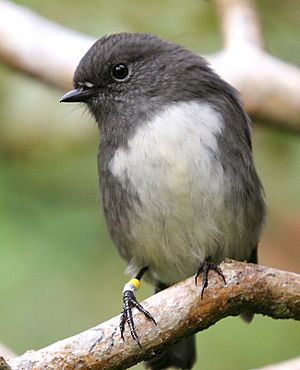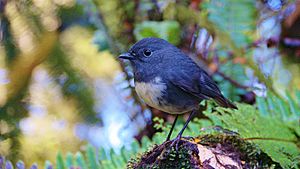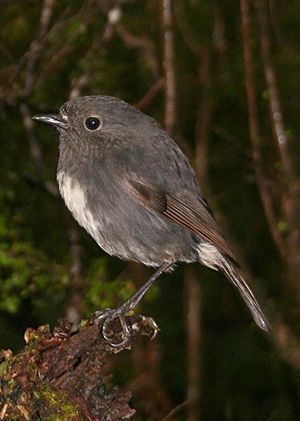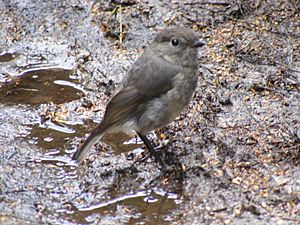South Island robin facts for kids
Quick facts for kids South Island robin |
|
|---|---|
 |
|
| Conservation status | |
| Scientific classification | |
| Genus: |
Petroica
|
| Species: |
australis
|
The South Island robin (Petroica australis) is a small bird, about the size of a house sparrow. You can only find this special bird in New Zealand. It is a protected species, meaning it is native to New Zealand and found nowhere else. These robins live in different parts of the South Island and Stewart Island/Rakiura. However, they are not found everywhere in these areas. There are two main types, or subspecies, of the South Island robin: the main one (P. australis australis) and the Stewart Island robin (P. australis rakiura). This bird is related to the North Island robin and the very rare black robin from the Chatham Islands.
Contents
Meet the South Island Robin: What is it?
The South Island robin has two main types, called subspecies:
- P. australis australis: This is the main type.
- P. australis rakiura: This is the Stewart Island robin.
These two types live in different places and do not mix. Other birds closely related to the South Island robin include the North Island robin (P. longipes), the tomtit (Petroica macrocephala), and the black robin (Petroica traversi). The black robin, found on the Chatham Islands, seems to have come from the same family as the South Island robin a long time ago. All these birds belong to a family called Petroicidae. This family has 49 different species, mostly found in Australia, New Zealand, and New Guinea.
Ancient Robins: A Look at Their History
Scientists believe that the robin family (Petroica) came to New Zealand from Australia in two separate waves. The South Island robin and North Island robin came in the first wave. The tomtit came in the second wave.
The South Island robin and North Island robin started to become different species before the Pleistocene Ice Age, about three million years ago. The two types of South Island robin (the main one and the Stewart Island robin) started to become different after the Ice Age, only about 10,000 years ago.
You can sometimes find fossils of New Zealand robins in places where animals fell into pits. This is because robins spend a lot of time looking for food on the ground. Fossils also show that robins used to live all over the lowlands of New Zealand. However, their homes were greatly reduced when the Polynesian ancestors of the Māori and later European settlers cut down many forests.
What Does a South Island Robin Look Like?
The South Island robin is a small bird, usually 10 to 18 centimeters long and weighing about 35 grams. It is a type of passerine bird, which means it is a perching bird.
It can be tricky to tell the difference between North Island robins, female South Island robins, young South Island robins, and all Stewart Island robins because they look quite similar.
Here's how to tell them apart:
- Male North Island robins: They are almost black with a white spot above their beak and a grayish-white lower chest.
- Female and young North Island robins: They are grayer with lighter patches on their chests and throats.
- Male South Island robins: They are dark grey, but they have a clear yellowish-white lower chest.
- Female and young South Island robins: They are lighter grey with a less clear patch on their chest.
- Stewart Island robins: Both males and females look similar to North Island robins.
New Zealand robins can live for a long time. Some have been known to live for at least 14 years in the wild!
Where Do South Island Robins Live?

In the past, South Island robins lived in most lowland areas of New Zealand's South Island. But over the last 100 years, they have lost a lot of their homes and faced new dangers from animals brought by humans. This has made their population much smaller and spread out.
You can find two groups of them on the east coast of the South Island. They are a bit more common in the north and west. The Stewart Island robin has had a harder time. It now lives in only three small groups, all in swampy areas with Leptospermum plants. This is not their favorite place to live, but it has fewer predators like stoats and cats. At one point, there were fewer than 500 Stewart Island robins left.
To help them, people started moving robins to islands where there are no predators, like Ulva Island, Motuara Island, and Nukuwaiata Island. This has worked well, and new populations have grown. For example, about 600 robins now live on Motuara Island alone.
In the South Island, these robins really like Douglas fir forests. They prefer these over native forests (like those with kanuka trees) or Monterey pine forests. This is because they like forests that are simple in structure, with dense, even tree tops and lots of leaf litter on the ground. When robins were moved to Ulva Island, they built more nests where there were broad-leaved coastal plants.
Robin Life: Behavior and Ecology
Reproduction and Family Life
South Island robins usually stay with one partner for life. It is very rare for them to have chicks with another bird. Since they stay together and do not move away from their breeding areas all year, the male and female in a territory will sometimes compete for food when they are not breeding. They try to find food in slightly different ways to avoid too much competition. However, they will steal food from their partner's hidden stash if they get the chance!
Males are usually stronger than females and will sometimes stop females from getting food. So, females often only get food when the male is not around. During the breeding season, the female builds the nest and sits on the eggs all by herself. The male's job is to bring food to the female and their new chicks.
South Island robins can start having babies when they are between six and 12 months old. They begin their breeding season quite early, in August or September (which is spring in the Southern Hemisphere). This means they can use any food left over from winter. They build open, cup-shaped nests in tree forks or inside tree holes. The eggs hatch after 18 days, and the chicks leave the nest after 21 days. The parents might lay more eggs and breed again just 5 to 25 days after their first chicks leave the nest.
Usually, they lay two eggs at a time. If their eggs or chicks are lost to predators, they can lay new eggs quickly, within 3 to 10 days.
How Robins Find and Store Food
South Island robins mostly eat small creatures without backbones, called invertebrates. These include earthworms, beetles, and other insects found in the leaf litter on the ground. They might hide (or cache) whole insects or parts of them. Each piece of food is hidden in a different spot. They usually store food within 10 meters of where they found it, even if they are outside their own territory.
In winter, their main stored food is earthworms. In summer, they tend to store cicadas. South Island robins have an amazing memory for where they hide their food. One male robin was seen emptying five hidden stashes in a row before taking the food back to his partner, who was sitting on eggs.
These birds can even tell the difference between caches of different sizes and remember up to 12 items without any special training. This is thought to be the highest number of items any wild animal has been recorded remembering! Because robins use a lot of energy, they might spend up to 90% of their day looking for or storing food during winter. South Island robins have also been seen eating berries sometimes, but they do not hide these.
Robin Songs and Sounds
When it's not breeding season, a male robin's call is a series of loud notes that get lower in sound. They start fast and then slow down. During the breeding season, males sing a full song to attract females. This full song is loud, clear, and can go on for more than 30 minutes with only very short breaks. They usually sing from the tops of tall trees.
Singing also seems to help robins control their body weight. Robins sing during the dawn chorus (when many birds sing at sunrise) and throughout the day. But they seem to sing more when there is plenty of food. When they have eaten more, they will do more energetic things, like singing, to reach a good weight by evening. So, even if two robins start the day at different weights, they will end the day at similar weights.
This behavior might also show how good a male is at finding food. The longer he sings, the better he is at finding food, which makes him a more attractive mate.
Protecting the South Island Robin
The South Island robin is listed as being of Least Concern on the IUCN Red List. This means it is not currently in danger of disappearing. However, the Stewart Island robin (Petroica australis rakiura) has faced some tough times recently. Its population has shrunk a lot because of forests being cut down, loss of its home, and new predators like rats, stoats, and wild cats.
Because the Stewart Island robin population dropped sharply, people have tried to move them to other nearby islands where there are no predators or where predators have been removed. However, many of these moves involved only 12 or fewer birds. This means that the birds often ended up breeding with close relatives, which can cause health problems. On Motuara Island, for example, many eggs did not hatch, and there were fewer nests. So, breeding with close relatives and its effects on their genes and health remain a worry for this type of robin.
On the other hand, robins on the South Island have not lost much of their genetic variety compared to how they used to be. However, their populations on the island are becoming more and more separated.
South Island Robins and 1080 Poison
Some robins have sadly died from accidentally eating 1080 poison. This happened during pest control operations. Most of these deaths were linked to four specific operations in the 1980s that used poor-quality carrot baits.
But apart from these cases, robins have generally done well when pest control programs use 1080 poison from the air. Their chicks and adult birds survive better, and their populations grow. A scientific study in 2012 by the University of Otago looked at a group of marked robins during a modern 1080 poison operation using cereal baits. The study found no negative effects on the robins. In fact, it suggested that the robin population likely increased because the poison reduced the number of predators like introduced mammals.
Images for kids
See also
 In Spanish: Petroica de la isla Sur para niños
In Spanish: Petroica de la isla Sur para niños










